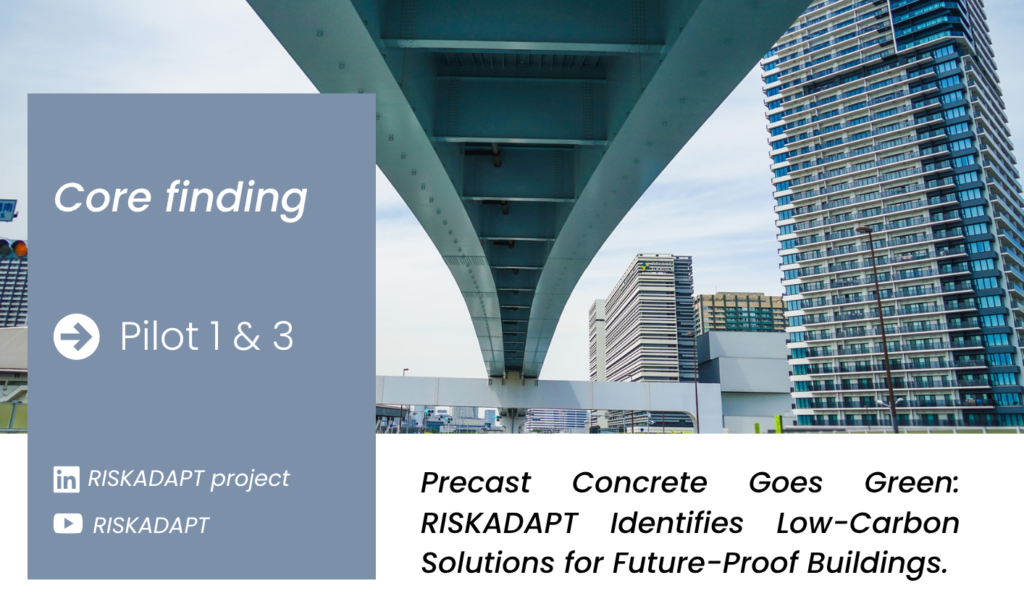
As climate change intensifies, Europe’s construction sector faces growing pressure to reduce its carbon footprint while ensuring buildings and infrastructure remain durable, safe, and resilient. Conventional concrete, though vital for modern structures, is responsible for significant CO₂ emissions linked to cement production and material use. This report, developed within the RiskADAPT project, explores practical pathways to make precast concrete a driver of low-carbon and climate-resilient construction.
Current practices often focus on individual measures—such as recycled materials or improved design—without fully integrating them into systemic, scalable solutions. This study bridges that gap by assessing five key areas where innovation can substantially cut emissions and improve resource efficiency: low-carbon binders, industrial by-products, recycled aggregates, reuse of concrete elements, and optimised structural design. Through life-cycle analysis and real-case scenarios, it highlights how combining these strategies can lower the carbon footprint of precast elements by up to 40%, while maintaining high technical performance.
This study, carried out by CERIB for BIBM under the RISKADAPT, examined how precast concrete can contribute to low-carbon, climate-resilient construction. Its goal was to identify practical and technically sound adaptation options that reduce greenhouse gas emissions while maintaining the strength, safety and durability of precast elements used in buildings and infrastructure.
What was done?
The report reviewed state-of-the-art literature and existing data to identify five main opportunities for carbon reduction in precast concrete:
- Low-carbon binders and cements;
- Use of industrial by-products (e.g. blast furnace slag, fly ash);
- Recycled aggregates from construction and demolition waste;
- Reuse of concrete elements;
- Optimised structural design using high-performance concrete.
These options were then translated into ten practical design cases (five for infrastructure and five for buildings) representing real-world precast components such as beams and columns. For each case, life-cycle assessments (LCA) were performed in line with EN 15804+A2 and EN 16757 standards to calculate the Global Warming Potential (GWP) and assess material efficiency.
Methods and approaches
The study used Environmental Product Declarations (EPDs) to benchmark typical and improved precast designs. It also drew on results from recent European projects – including VEEP, RE4 and SeRaMCo -that tested recycled and reusable concrete products. Comparative analyses examined how different cement types, aggregate sources and design optimisations affect embodied carbon per linear metre of precast elements.
Main results
The findings show that low-carbon binders (especially CEM III cements with high slag content) and structural optimisation can achieve carbon reductions of up to 40% compared with conventional mixes. Substituting natural aggregates with 20% recycled aggregates produced limited but positive results, depending on transport distance and material quality.
- A standard precast beam (C30/37) using CEM I cement emits around 123 kg CO₂ eq/m.
- Using CEM III instead reduces emissions to about 98 kg CO₂ eq/m.
- For high-strength designs (C60/75), emissions can drop further to 58 kg CO₂ eq/m.
Projects like ReCreate demonstrated that reusing structural elements can lower embodied carbon by up to 90% during the production phase.
How results adress the need
These outcomes directly respond to the construction sector’s dual challenge: reducing carbon emissions and adapting infrastructure to harsher climatic conditions. By quantifying feasible solutions, the study provides concrete pathways for industry to act within upcoming EU sustainability frameworks and climate adaptation goals.
Innovation compared to practice
Unlike conventional approaches that tackle emissions at material or process level alone, this work integrates multiple levers – materials, design, and reuse – into a single performance-based strategy. It demonstrates that precast concrete, often perceived as energy-intensive, can become a key enabler of low-carbon, circular and climate-resilient construction when supported by standardised assessment tools and collaborative industrial innovation.
Conclusions & Next steps
The study confirms that precast concrete can play a leading role in Europe’s transition toward low-carbon and climate-resilient construction. Scientifically, it provides robust life-cycle data and validated design scenarios that demonstrate measurable carbon reductions – evidence that will inform future research and standardisation in sustainable construction materials. Technically, it establishes replicable benchmarks for using low-carbon binders, recycled aggregates and optimised designs, offering industry-ready models for decarbonising concrete production.
From a policy perspective, the results support EU initiatives such as the Circular Economy Act, Climate Adaptation Plan and Sustainable Construction Framework, by showing how material performance and durability can align with emission-reduction goals. Societally, the findings promote more resource-efficient and affordable solutions for resilient infrastructure and housing.
The next steps within RiskADAPT will focus on demonstrating these approaches in pilot sites, refining the environmental assessment models, and engaging with policymakers and standardisation bodies (CEN/TC 229 and CEN/TC 350) to integrate the findings into future European standards and guidance documents. Ultimately, these results pave the way for a broader uptake of circular and low-carbon design principles across the built environment.
